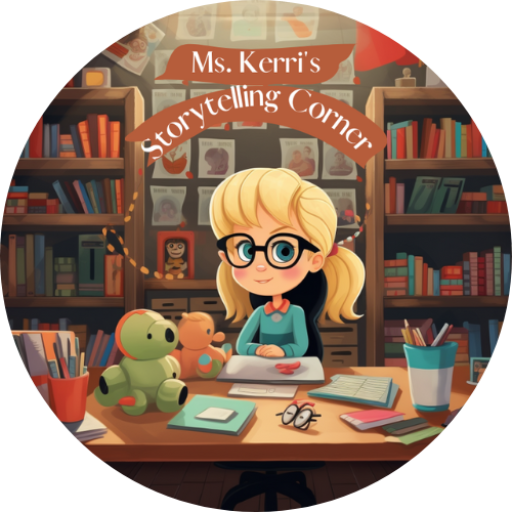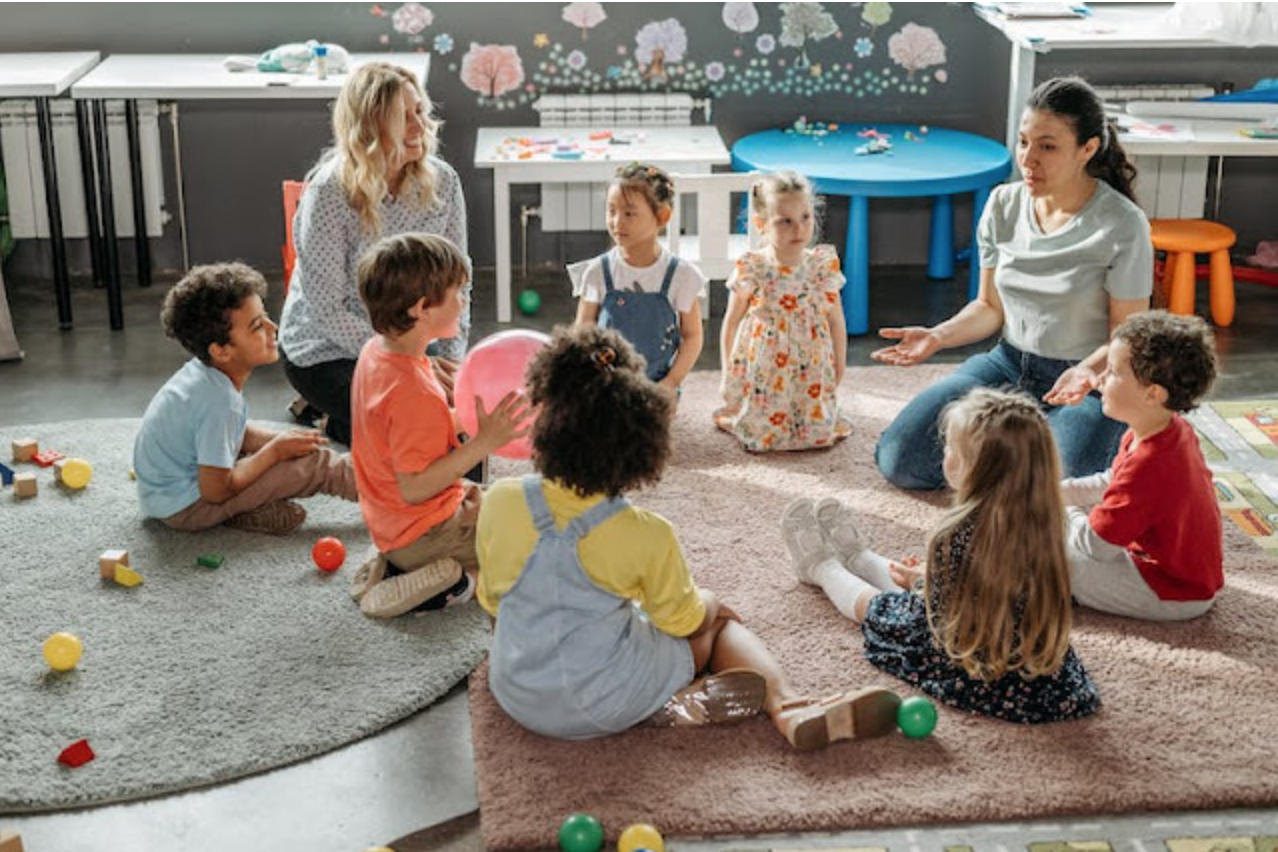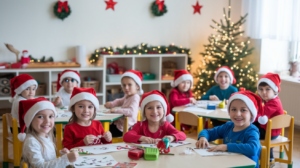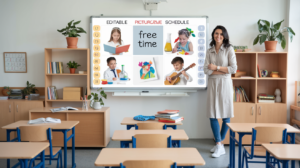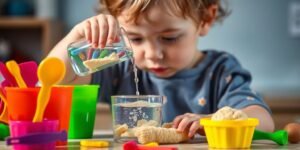Creating inclusive preschool environments is essential for nurturing every child’s sense of belonging and fostering their development. This article delves into strategies for accommodating diverse learning needs, promoting emotional intelligence, designing inclusive spaces, building family trust, and encouraging exploration and creativity. These efforts contribute to a supportive and engaging early education experience that benefits all children.
Key Takeaways
- Effective sensory integration strategies and occupational therapy can be integrated into daily routines to support children with diverse learning needs.
- Emotional intelligence and mindfulness can be cultivated in young children through meditation, relaxation techniques, and a culture of empathy.
- Inclusive play and learning spaces are designed with visual aids, labels, and adaptations to accommodate children of varied abilities.
- Building strong communication and trust with families is crucial for creating a seamless transition and reflecting community diversity in the classroom.
- Encouraging exploration and creativity through art, STEM, literacy, and environmental stewardship extends learning and prepares children for future academic success.
Understanding and Supporting Diverse Learning Needs
Incorporating Sensory Integration Strategies
Sensory integration is key to cognitive learning. By tailoring environments to meet sensory needs, we unlock potential. Every child’s sensory profile is unique; understanding this is the first step to inclusion.
- Offer sensory tools like fidget toys and noise-canceling headphones.
- Use visual supports: schedules, timers, and cues.
- Adapt to individual sensory preferences for optimal learning.
Sensory strategies are not one-size-fits-all. They’re a dynamic toolkit, evolving with each child’s journey.
Remember, a well-integrated sensory approach paves the way for a smoother educational experience. It’s about creating a space where sensory processing is not a barrier, but a bridge to learning and growth.
Pediatric Behavior and Occupational Therapy Integration
Integrating pediatric behavior and occupational therapy creates a synergy that addresses the holistic needs of children. Play-based learning and family involvement are key to this approach, enhancing social skills, communication, and cognitive development.
- Inclusive Play Development: Tailoring activities to foster social interaction.
- Milestone Tracking: Monitoring progress to personalize therapy.
- Pediatric OT Academic Support: Aligning therapy with educational goals.
By weaving occupational therapy into daily routines, we ensure a seamless and comprehensive educational experience for every child.
Combining therapies like speech, occupational, and behavior therapy tailors support to each child’s unique journey, promoting a richer developmental outcome.
Milestone Tracking and Individualized Education Plans
Every child’s journey is unique, and milestone tracking ensures no one falls through the cracks. By charting individual progress, educators can tailor education plans to meet the specific needs of each preschooler.
- Personalized Learning: Customized strategies for every child.
- Progress Monitoring: Regular assessments to celebrate growth.
- Family Involvement: Parents as partners in education.
Embrace the diversity of development by integrating milestone tracking into daily routines. This holistic approach not only supports academic success but also nurtures the child’s overall well-being.
The goal is clear: to provide a supportive and adaptive environment where every child can thrive. With the right tools and a collaborative spirit, educators and families work together to pave the way for a bright and inclusive future.
Fostering Emotional Intelligence and Mindfulness
Introducing EQ Through Meditation and Relaxation Techniques
In the realm of early education, fostering emotional intelligence (EQ) is as crucial as teaching ABCs. Meditation and relaxation techniques are powerful tools in this quest, helping little ones recognize and manage their emotions. The Reggio Emilia approach inspires us to view children as capable beings, full of potential and ready to explore their inner worlds through mindfulness.
- Calm Breaths: Teach children to focus on their breathing to find calm.
- Quiet Time: Dedicate moments in the day for silent reflection.
- Guided Imagery: Use stories to guide them through peaceful scenarios.
By integrating these practices into daily routines, we lay the groundwork for a more mindful generation. Children learn to pause, reflect, and respond rather than react impulsively.
Embracing these techniques not only soothes the mind but also enhances learning readiness. When children are calm, their capacity to absorb new information expands. Let’s cultivate these seeds of tranquility and watch our little ones grow into emotionally intelligent individuals.
Creating a Culture of Empathy and Understanding
Empathy is the heart of an inclusive preschool. It’s about seeing the world through each child’s eyes. Fostering empathy is more than a lesson; it’s a daily practice that shapes compassionate future citizens.
Communication is key. Active listening and open dialogues are the building blocks of empathy. Here’s how we can integrate empathy into our daily routine:
- Active Listening: Pay full attention to the children, showing them that their voices matter.
- Open Dialogues: Encourage children to express their feelings and thoughts.
- Shared Activities: Collaborate on tasks that promote teamwork and understanding.
- Celebrating Achievements: Recognize and honor each child’s milestones, big or small.
By embedding these practices into our curriculum, we create a nurturing environment that values every child’s unique contributions.
Patience and consistency are our allies in this journey. As we work together, we lay the groundwork for a community where every child feels understood and valued.
Mindfulness for Little Minds: Activities and Practices
In the realm of early education, mindfulness is more than a buzzword; it’s a foundational skill. Cultivating mindfulness early paves the way for emotional resilience and self-awareness. Here are some engaging activities to introduce mindfulness to preschoolers:
- Breathing buddies: Children lie down with a stuffed animal on their bellies, watching it rise and fall with each breath.
- Mindful munching: During snack time, encourage kids to notice the taste, texture, and sensations of their food.
- Yoga stretches: Simple yoga poses can help children connect with their bodies and the present moment.
By integrating mindfulness into daily routines, we create a calm, focused atmosphere conducive to learning and growth.
Remember, the goal is not to eliminate distractions, but to teach little ones the art of gentle refocusing. With practice, children learn to manage their thoughts and emotions, leading to a harmonious classroom environment.
Designing Spaces for Inclusive Play and Learning
Adapting Classrooms for Varied Abilities
Creating an inclusive preschool environment means ensuring every child, regardless of ability, feels welcome and engaged. Adapting classrooms for varied abilities is not just about accessibility; it’s about fostering a sense of belonging.
- Flexibility in classroom design allows for a range of activities that cater to different learning styles.
- Montessori-inspired materials encourage self-directed exploration and cater to individual pacing.
- Visual schedules and cues support children with autism, enhancing predictability and organization.
Tailoring environments to meet diverse needs promotes successful participation and access to everyday activities. This concept revolves around making adaptations to accommodate various requirements and ensuring inclusivity.
Remember, adaptations do not involve teaching new skills but rather enable all children to participate fully in their educational journey. Collaboration with parents ensures that these adaptations are effective and personalized, reflecting the unique needs of each child.
Inclusive Play Development in Preschool Settings
Inclusive play is the cornerstone of every child’s development. Playgrounds should be a place where every child feels welcome. To achieve this, organize by clustering similar play activities together and ensure accessible pathways to these areas. Include designated quiet zones for children needing a break from the hustle and bustle.
- Accessible Pathways: Smooth, wide paths for all mobility needs.
- Varied Play Equipment: Options for different skill levels and interests.
- Quiet Zones: Safe spaces for sensory breaks or calm play.
Inclusive play areas are not just about accessibility; they’re about creating opportunities for all children to engage, explore, and learn together.
By tailoring play-based learning to the unique needs of children, especially those with Autism Spectrum Disorder (ASD), we foster improvements in social interaction and cognitive growth. Cognitive and problem-solving development is enhanced through imaginative play, boosting mental abilities and promoting independence. Tailoring these games to target specific therapeutic goals, such as emotional regulation or language development, maximizes their effectiveness.
Utilizing Labels and Visual Aids to Enhance Learning
Visual aids are not just accessories; they’re essential tools for inclusive learning. Labels and visual aids bridge the gap between abstract concepts and tangible understanding, especially for visual learners.
- Graphic organizers help children see connections, making complex ideas more accessible.
- Picture schedules offer a clear view of the day, providing comfort through predictability.
- Diagrams simplify intricate subjects, and written instructions reinforce verbal cues.
Embrace visual strategies to support every learner’s journey.
Remember, repetition is key. It solidifies learning for all styles, from visual to auditory. For auditory learners, consider recorded lessons or read-alouds, which can be revisited for reinforcement. Discussion boards and written materials cater to those who learn best through reading and writing.
By thoughtfully integrating visual aids, we create a playful, literacy-rich environment that speaks to every child. This approach aligns with the National Association for the Education of Young Children’s (NAEYC) recommendations, ensuring a well-rounded educational experience.
Building Trust and Communication with Families
Engaging with Parents for a Smooth Transition
Transitioning to preschool is a milestone for both children and parents. Open communication is key to a seamless experience. Here’s how to make it work:
- Prepare parents with a clear outline of what to expect.
- Collaborate on a transition plan that considers the child’s unique needs.
- Use a fun icebreaker to help parents get to know each other.
By focusing on the child’s strengths and interests, we create a joyful learning journey.
Remember, every child is unique. Tailoring strategies to meet individual preferences ensures a supportive learning environment. Engage in regular check-ins to adapt and refine the transition plan. Together, we can make preschool a place where every child thrives.
Reflecting Community Diversity in Classroom Decor
Embrace the mosaic of cultures that enrich your preschool by weaving diversity into the very fabric of your classroom decor. Boldly showcase the world through art, artifacts, and materials that reflect the varied backgrounds of your students and their families.
- Celebrate cultural festivals with authentic decorations.
- Display books and stories from around the globe.
- Rotate displays to honor different cultures each month.
Creating a space that mirrors the diversity of the community fosters a sense of belonging and inclusivity among young learners.
Remember, a classroom that mirrors the real world prepares children for a multicultural society. It’s not just about aesthetics; it’s about shaping worldviews and nurturing global citizens from the earliest years.
Teachers You Can Trust: Building Relationships
At the heart of every inclusive preschool is a team of dedicated educators. Trust is the cornerstone of the relationship between teachers, children, and families. Our educators are not just qualified; they’re chosen for their innate ability to connect and contribute positively to a child’s development.
Communication is key to building these relationships. Regular updates, open dialogues, and a transparent approach ensure that families are always in the loop. Here’s how we engage:
- Open-door policy: Encouraging parents to participate in classroom activities.
- Regular feedback: Sharing children’s progress and milestones.
- Community events: Strengthening bonds through shared experiences.
We believe in a partnership that nurtures a child’s growth both at school and at home. By working closely with families, we create a seamless support system that extends beyond the classroom walls.
Our commitment to family engagement is reflected in our practices and the positive outcomes they yield. By creating a learning environment that complements the children’s home life, we foster a sense of belonging and community.
Encouraging Exploration and Creativity in Early Education
Art, STEM, and Literacy in the Prekindergarten Classroom
In the vibrant world of prekindergarten, preschool activities are more than just play. They’re the building blocks of a child’s future. Art integration is key, aligning lessons with naturally-aligned art concepts to foster creativity and critical thinking.
- Art Integration
Art is not just about colors and shapes; it’s a pathway to understanding complex ideas.
In our classrooms, every scribble tells a story. Every block tower engineers young minds. Every book opens a door to a universe of words.
By intertwining art, STEM, and literacy, we lay a foundation for holistic education. Children learn to express themselves, not just with crayons and paint, but with the language of innovation and inquiry. Our approach is hands-on, engaging, and tailored to kindle the joy of learning in every child.
Fun Ways Kids Can Engage in Recycling and Environmental Stewardship
Teaching children about recycling is not just a lesson; it’s a lifestyle change. Every small step counts towards a greener future. Here are some engaging ways to incorporate recycling into preschool activities:
- Sorting Game: Turn recycling into a fun game by having kids sort items into bins labeled ‘paper’, ‘plastic’, and ‘metal’.
- Craft from Scraps: Encourage creativity by using scrap materials to create art. Old magazines, fabric, and cardboard can transform into masterpieces.
- Nature Walks: Collect litter during nature walks to teach responsibility for our planet.
By embedding these practices into daily routines, children learn the value of sustainability from a young age.
Remember, the goal is to make recycling a natural part of children’s lives. Celebrate their efforts and watch as they become little ambassadors for the environment.
Before- and After-School Programs: Extending Learning Beyond the Classroom
Extend the boundaries of early learning with before- and after-school programs that captivate young minds. These programs are not just about care; they’re about project-based learning for children, where every activity is an opportunity to explore and grow.
- Hands-on Projects: From science experiments to art exhibitions, children apply what they learn in a tangible way.
- Skill Development: Enhancing social, cognitive, and motor skills through structured and free play.
- Community Connection: Activities that reflect and celebrate the diversity of the families we serve.
Embrace the full spectrum of early childhood learning, ensuring that every moment is packed with discovery and joy.
By integrating project-based learning, we’re not just keeping children busy; we’re igniting a passion for knowledge that lasts well beyond the school day.
Unlock the full potential of your child’s early education by fostering a love for exploration and creativity. At Ms. Kerri’s Story Telling Corner, we provide a treasure trove of resources that make learning an adventure. From interactive storytime sessions to downloadable educational materials, we have everything you need to support your child’s cognitive and creative development. Don’t wait to ignite your child’s passion for learning—visit our website today and discover the joy of early education done right!
Conclusion
As we reflect on the journey of creating inclusive preschool environments, it’s clear that every child, regardless of their background or abilities, deserves a place where they can thrive and feel a sense of belonging. From the nurturing care in infant programs to the explorative and educational activities in prekindergarten classrooms, inclusivity is about meeting each child where they are and providing them with the support to grow. It’s about crafting spaces that not only accommodate all children but also celebrate their unique contributions to the learning community. By prioritizing inclusive play development, milestone tracking, and integrating therapies and support strategies, we pave the way for a more compassionate and understanding future. Let us continue to build preschool environments where every child knows they belong, and their potential is limitless.
Frequently Asked Questions
How do inclusive preschool environments cater to diverse learning needs?
Inclusive preschools incorporate sensory integration strategies, occupational therapy, and individualized education plans to support children with varied learning needs. These approaches ensure that each child’s unique developmental milestones are met.
Why is emotional intelligence important in preschool education?
Emotional intelligence (EQ) is crucial for children to understand and manage their emotions, develop empathy, and build strong relationships. Preschools foster EQ through meditation, relaxation techniques, and activities that promote mindfulness and empathy.
What features make a preschool classroom inclusive for children with different abilities?
An inclusive preschool classroom is adapted to accommodate children with varied abilities. This includes using labels, visual aids, and designing spaces that allow for inclusive play and learning opportunities for all children.
How can preschools build trust and effective communication with families?
Preschools can build trust with families by engaging parents in the transition process, reflecting community diversity in the classroom decor, and establishing strong, reliable relationships between teachers and families.
What role does creativity play in early childhood education?
Creativity is essential in early education as it encourages exploration and problem-solving. Activities like art, STEM, and literacy projects stimulate prekindergarteners’ minds and prepare them for future academic success.
How do before- and after-school programs extend learning for preschoolers?
Before- and after-school programs offer additional opportunities for learning and development beyond the regular classroom setting. These programs can include environmental stewardship, recycling activities, and extended academic enrichment.


Ms. Kerri’s Corner provides a exciting virtual space for preschool learning. Through a variety of engaging activities, she exposes young minds to early math, literacy, science and social-emotional skills in a developmentally appropriate way. Centers for blocks, art, books and music allow children to explore hands-on learning at their own pace. Guided lessons subtly introduce number sense, letter sounds and narrative thinking. Careful observation gives insight into each child’s progress across domains. Viewers are also invited to participate, reinforcing that their ideas are valued. By making learning fun yet purposeful, Ms. Kerri lays the groundwork for future academic success while fostering creativity and imagination. Her program offers preschoolers valuable screen-based learning experiences.
